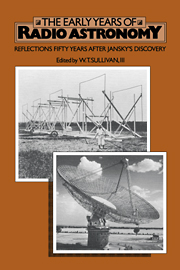Book contents
- Frontmatter
- Contents
- Preface
- THE EARLIEST YEARS
- Karl Jansky and the discovery of extraterrestrial radio waves
- Early radio astronomy at Wheaton, Illinois
- Optical and radio astronomers in the early years
- AUSTRALIA
- ENGLAND
- THE REST OF THE WORLD
- BROADER REFLECTIONS
- Biographical notes on contributors
- Name index
- Subject index
Early radio astronomy at Wheaton, Illinois
Published online by Cambridge University Press: 05 March 2010
- Frontmatter
- Contents
- Preface
- THE EARLIEST YEARS
- Karl Jansky and the discovery of extraterrestrial radio waves
- Early radio astronomy at Wheaton, Illinois
- Optical and radio astronomers in the early years
- AUSTRALIA
- ENGLAND
- THE REST OF THE WORLD
- BROADER REFLECTIONS
- Biographical notes on contributors
- Name index
- Subject index
Summary
My interest in radio astronomy began after reading the original articles by Karl Jansky (1932, 1933). For some years previous I had been an ardent radio amateur and considerable of a DX [Distance Communication] addict, holding the call sign W9GFZ. After contacting over sixty countries and making WAC [“worked all continents”], there did not appear to be any more worlds to conquer.
It is interesting to see how the mystifying peculiarities of short-wave communications of 1930 gradually have been resolved into an orderly whole. The solar activity minimum of the early thirties must have brought with it abnormally low critical frequencies. Many a winter night was spent fishing for DX at 7 Mc/s when nothing could be heard between midnight and dawn. It is now clear that the MUF [maximum usable frequency] over all of North America was well below 7 Mc/s for several hours. An hour after sunset when the west coast stations disappeared 14 Mc/s went dead. These years would have been a very fine time for low-frequency radio astronomy. The now appreciated long quiesence of the sun during the latter half of the seventeenth century (Schove 1955) would have been even better!
One further recollection is that on these quiet nights it was always possible to make the receiver quieter by taking off the antenna. This receiver uses a regenerative detector and one RF [radio frequency] stage. The detector and RF stage are tuned separately so that the latter may be gradually tuned across the former. When this was done with the antenna off, no appreciable change could be heard in the sound of rushing water.
- Type
- Chapter
- Information
- The Early Years of Radio AstronomyReflections Fifty Years after Jansky's Discovery, pp. 43 - 66Publisher: Cambridge University PressPrint publication year: 1984
- 4
- Cited by



